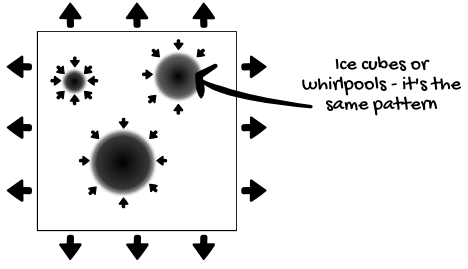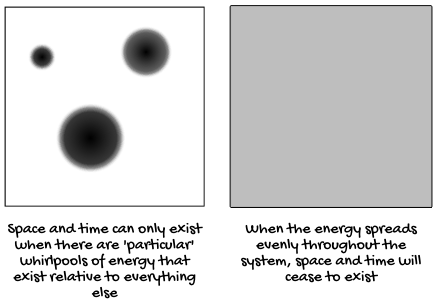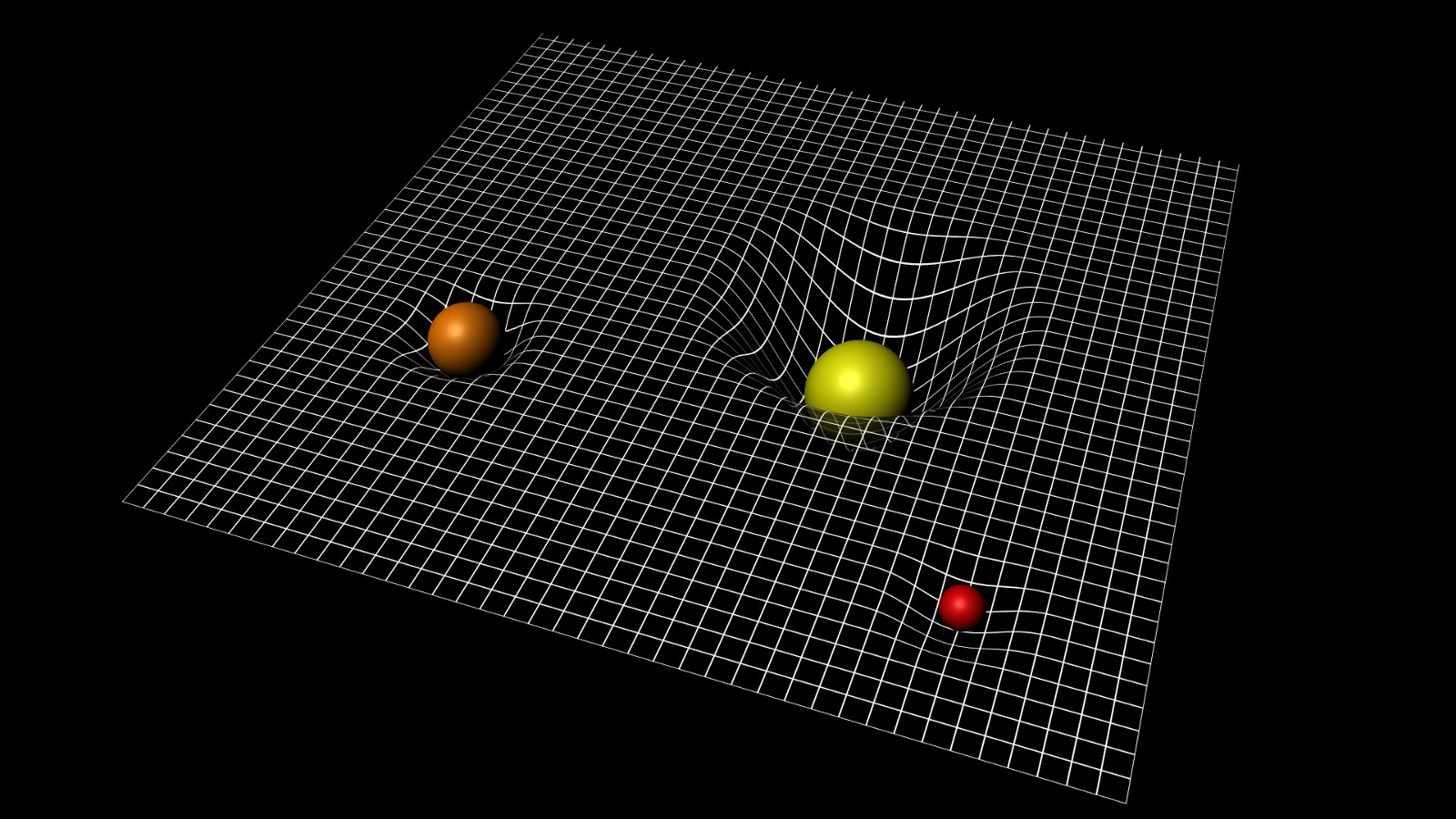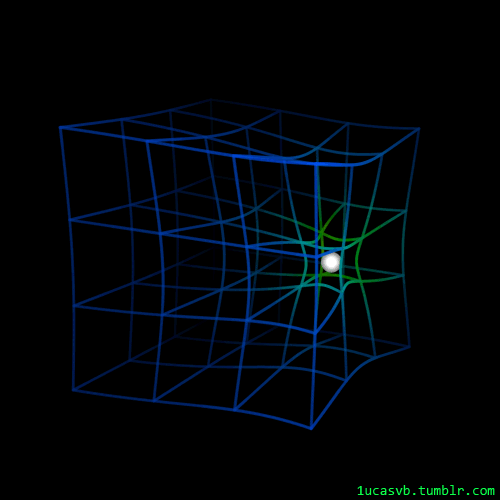"Exactly," I said. "We're looking past all the noise, and distilling the universe down to that core pattern: the pull towards entropy, and the push against it. Now, I'm going to read a relevant passage from The Holographic Universe."
Psychiatrist David Shainburg, associate dean of the Postgraduate Psychoanalytic Program at the William Alanson White Institute of Psychiatry in New York, feels Bohm’s assertion that thoughts are like vortices in a river should be taken literally and explains why our attitudes and beliefs sometimes become fixed and resistant to change. Studies have shown that vortices are often remarkably stable. The Great Red Spot of Jupiter, a giant vortex of gas over 25,000 miles wide, has remained intact since it was first discovered 300 years ago. Shainburg believes this same tendency toward stability is what causes certain vortices of thought (our ideas and opinions) to become occasionally cemented in our consciousness.
He feels the virtual permanence of some vortices is often detrimental to our growth as human beings. A particularly powerful vortex can dominate our behaviour and inhibit our ability to assimilate new ideas and information. It can cause us to become repetitious, create blockages in the creative flow of our consciousness, keep us from seeing the wholeness of ourselves, and make us feel disconnected from our species.
Like Bohm, Shainberg believes our consciousness is constantly unfolding out of the implicate order, and when we allow the same vortices to take form repeatedly he feels we are erecting a barrier between ourselves and the endless positive and novel interactions we could be having with this infinite source of all being.
To catch a glimmer of what we are missing, he suggests we look at a child. Children have not yet had the time to form vortices, and this is reflected in the open and flexible way they interact with the world. According to Shainberg, the sparkling aliveness of a child expresses the very essence of the unfolding-enfolding nature of consciousness when it is unimpeded.
If you want to become aware of your own frozen vortices of thought, Shainberg recommends you pay close attention to the way you behave in conversation. When people with set beliefs converse with others, they try to justify their identities by espousing and defending their opinions. Their judgements seldom change as a result of any new information they encounter, and they show little interest in allowing any real conversational interaction to take place. A person who is open to the flowing nature of consciousness is more willing to see the frozen condition of the relationships imposed by such vortices of thought. They are committed to exploring conversational interactions, rather than endlessly repeating a static litany of opinions.
Michael Talbot
Zac blinked a few times. "Err… how is that relevant?"
"Don't you see the connection?" I asked.
"No."
"The psychiatrist, Shainberg, is using water as a metaphor for consciousness. It's the same pattern as our ice cube model of the universe. A 'frozen' vortice of thought is like an ice cube. It is something in particular. The stronger the idea, the more frozen it becomes, and the deeper the whirlpool spins. Similarly, in our ice cube model, the more energy applied to keep an ice cube cool, the more that ice cube will resist entropy and stay 'intact.' Both models have the same mathematical patterns at play: the pull towards entropy, and the push against it. Do you see it now?"

"Yeah," Zac said.
"Good. Now, we're going to let this whirlpool model take over from our ice cube model. It will be easier to explain spacetime using whirlpools.
So, imagine our whirlpool model had reached a state of maximum entropy. There would be no particular whirlpools in the ocean anymore. The water would be perfectly calm and flat. Because there are no specific whirlpools or features to distinguish one section of water from another, all points will become equal to all other points. Relativity will disappear."

"So," I said, "what does that remind you of — being everything and therefore nothing in particular?"
Zac looked at me with a blank face. "God?"
"Yes, God. But I was actually thinking about meditation. When you quiet your mind, you rid yourself of the humdrum and specificity of your own thoughts and beliefs. Imagine a universe existing in a monk's mind. Specific ideas are represented by physical matter in this 'universe.' As the monk quiets his mind, the specificity goes away. It's like the ocean calms down, and the whirlpools disappear."
"Yeah, I get it," Zac said. "But if my consciousness is a holographic fragment of God's consciousness, shouldn't the same pattern occur in the universe?"
"It does," I replied. "That's the second law of thermodynamics: the entropy of an isolated system always stays the same or increases. So, in theory, the universe should eventually become a calm ocean. Space and time will cease to exist when there are no whirlpools in the fabric of spacetime. You can even think of spacetime as an ocean. Here, look at this diagram…"

"This is the mental model Einstein used to explain general relativity. Einstein realized that concentrations of energy warp spacetime. Gravity is a natural consequence of that warping. He likened it to placing a bowling ball on a trampoline. The heavier the bowling ball, the deeper the trampoline will bend. If other objects are on the trampoline, they will fall towards the bowling ball via the path of least resistance. You can even visualize this model with an extra dimension, which is more accurate..."

"John Archibald Wheeler succinctly summed up general relativity like this: spacetime tells matter how to move; matter tells spacetime how to curve."
"Wait," Zac cocked his head to the side. "You're saying that the curvature of spacetime around mass is like the curvature of the ocean around whirlpools."
"Yes," I said. "It's the same pattern. Stronger whirlpools, with more energy focused on them, have a greater attractive pull. It's like when you focus on an idea in your consciousness. As you focus, more and more similar ideas gather around it and combine with it, giving it more mass — and thus, a more attractive pull. Remember — as above, so below; as within, so without. The same mathematical pattern that organizes the universe also organizes your consciousness. It's a holographic pattern."

"Are you still following?" I asked.
"Yep," Zac replied.
"Good. Now let's just pause here to sum up our model so far. I'm going to be layering on different concepts, so it's important that you understand the foundations.
Firstly, all systems have a mathematical pull in the direction of higher entropy; they will naturally move from low probability 'ordered' states, to high probability 'chaotic' states.
Secondly, conscious systems will push in the opposite direction. They will resist entropy by moving from high probability 'chaotic' states, to low probability 'ordered' states.
Thirdly, resisting entropy requires work. Energy needs to be expended to keep something in a particular, ordered state — like an ice cube, or an assembled puzzle.
Fourth, this mathematical push-pull forms the basis of our system. The algorithm that organizes the universe should have a mathematical pull towards entropy, and a mathematical push against it.
Fifth, we already see this push-pull pattern play out in the universe and our own consciousness. As above, so below; as within, so without. Just like a massive star has a gravitational pull in our outer reality, so does a massive idea in your mind. The more energy you feed an idea, the stronger its whirlpool becomes, and the more similar ideas you attract to it.
Are these patterns making sense? Do you understand the abstraction so far?"
"I think so," Zac said.
"Good. Because this is a very deep rabbit hole. Let me know if I'm losing you."
"You're not."

